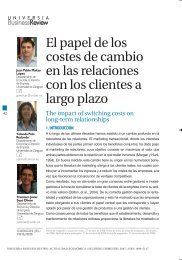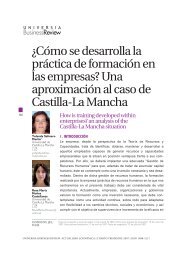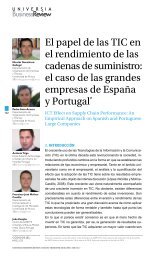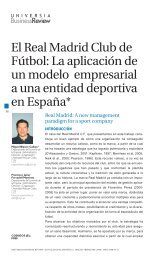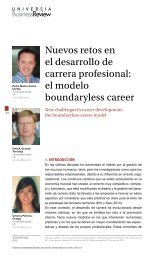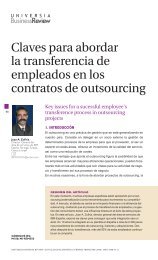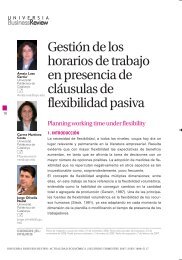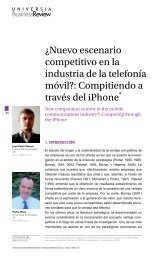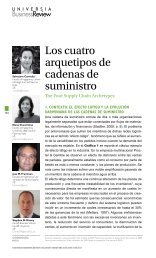ubr-universia-business-review
ubr-universia-business-review
ubr-universia-business-review
- No tags were found...
Create successful ePaper yourself
Turn your PDF publications into a flip-book with our unique Google optimized e-Paper software.
Pablo Rodríguez-Gutiérrez, Fernando J. Fuentes-García &<br />
Sandra Mª Sánchez-Cañizares<br />
2. CSR DISCLOSURE: CSR REPORTS AS A TOOL FOR TRANS-<br />
PARENCY IN ORGANIZATIONS<br />
The contribution of relevant information and access to the same for<br />
interest groups, promotes the transparency of organisations (AECA,<br />
2004), resulting in the achievement of a double objective: the activity<br />
of the entities can be justified to society (legitimacy theory) as<br />
well as satisfying the information needs of different interest groups<br />
(stakeholder theory).<br />
The growing need for information and the demand for greater transparency<br />
in information from society have resulted in a need to<br />
make the behaviour of entities more visible. According to Gray et al.<br />
(1996), this has translated into a process of accountability of social<br />
and environmental impacts resulting from the economic activity of<br />
organisations to specific groups and society in general. This social<br />
nature of responsibility, due to another person or the society, involves<br />
the obligation of disclosure and transparency, which is increasingly<br />
being put into practice by means of the presentation of social<br />
reports or social reporting.<br />
These reports overcome the lack of flexibility and adaptation of traditional<br />
accountancy to bring together information of a social and<br />
environmental nature giving a new dimension to the concept of<br />
accounting. Despite still not being used by most entities, they are<br />
becoming an alternative method to traditional reports. Recently,<br />
some studies have begun to reflect on the growing importance of<br />
this specific method of communicating social and environmental information<br />
(for example, Aranguren and Ochoa, 2008 and Hassan,<br />
2010). From this point of view, as indicated by Gray et al. (1996),<br />
social reports can be considered the main channel for communicating<br />
the social and environmental impact of a company’s economic<br />
activity as regards interest groups which affect the entity. The main<br />
advantage is that by publishing the information separately from the<br />
annual report, it is easier for interested parties to gain access to the<br />
report itself, thereby improving its disclosure (Observatorio RSC,<br />
2011).<br />
In this sense, initiatives such as those of the Global Reporting Initiative<br />
(GRI) have played a significant role by offering clear guidelines<br />
for disclosing information about the social involvement of entities;<br />
so much so that almost all Spanish FIs follow these regulations<br />
when preparing their social reports, with all of them obtaining the<br />
maximum grade possible (Appendix 1).<br />
KEY WORDS<br />
Content analysis,<br />
Banking sector, GRI,<br />
CSR<br />
PALABRAS CLAVE<br />
Análisis de contenido,<br />
Sector financiero, GRI,<br />
RSC<br />
87<br />
UNIVERSIA BUSINESS REVIEW | SEGUNDO trimestre 2013 | ISSN: 1698-5117



